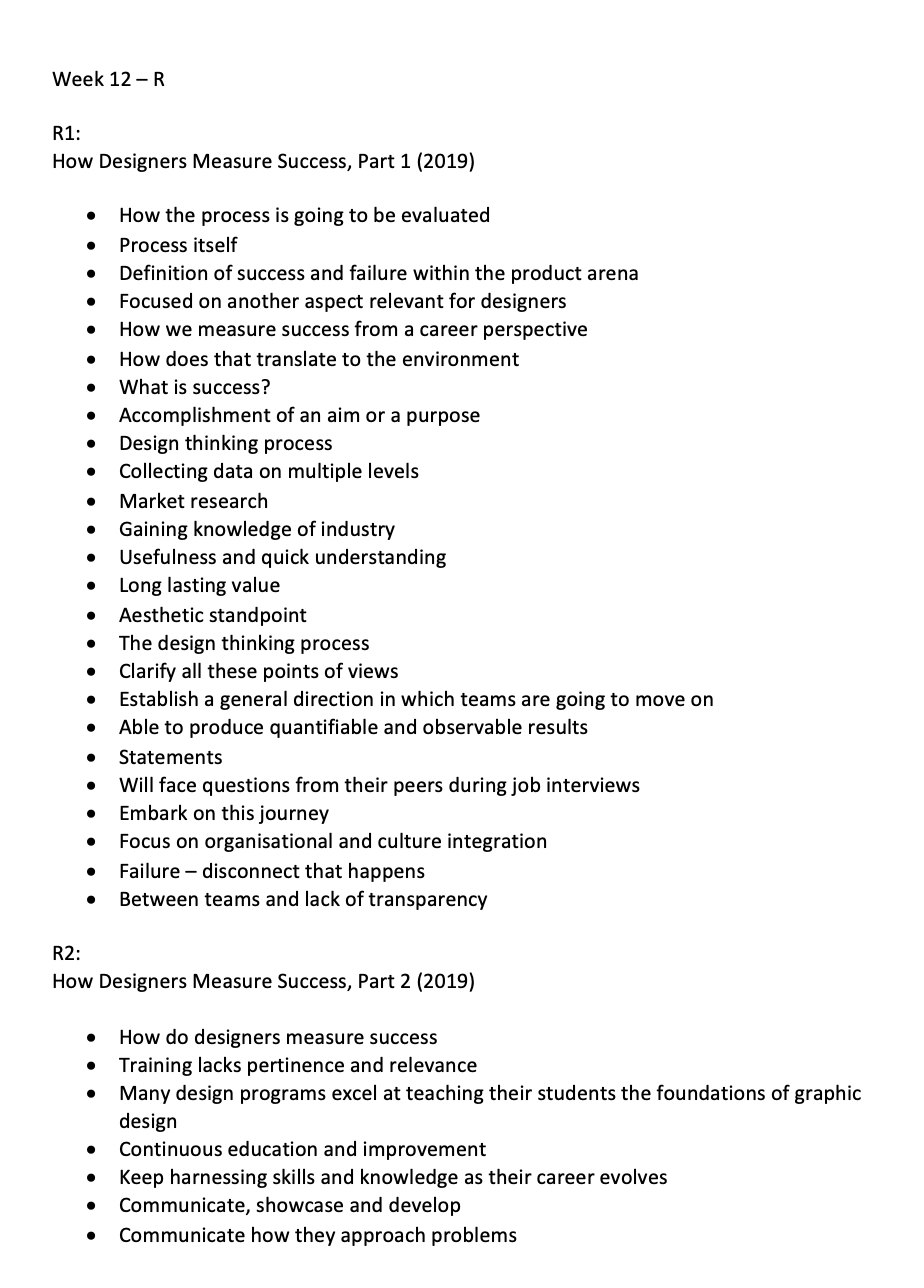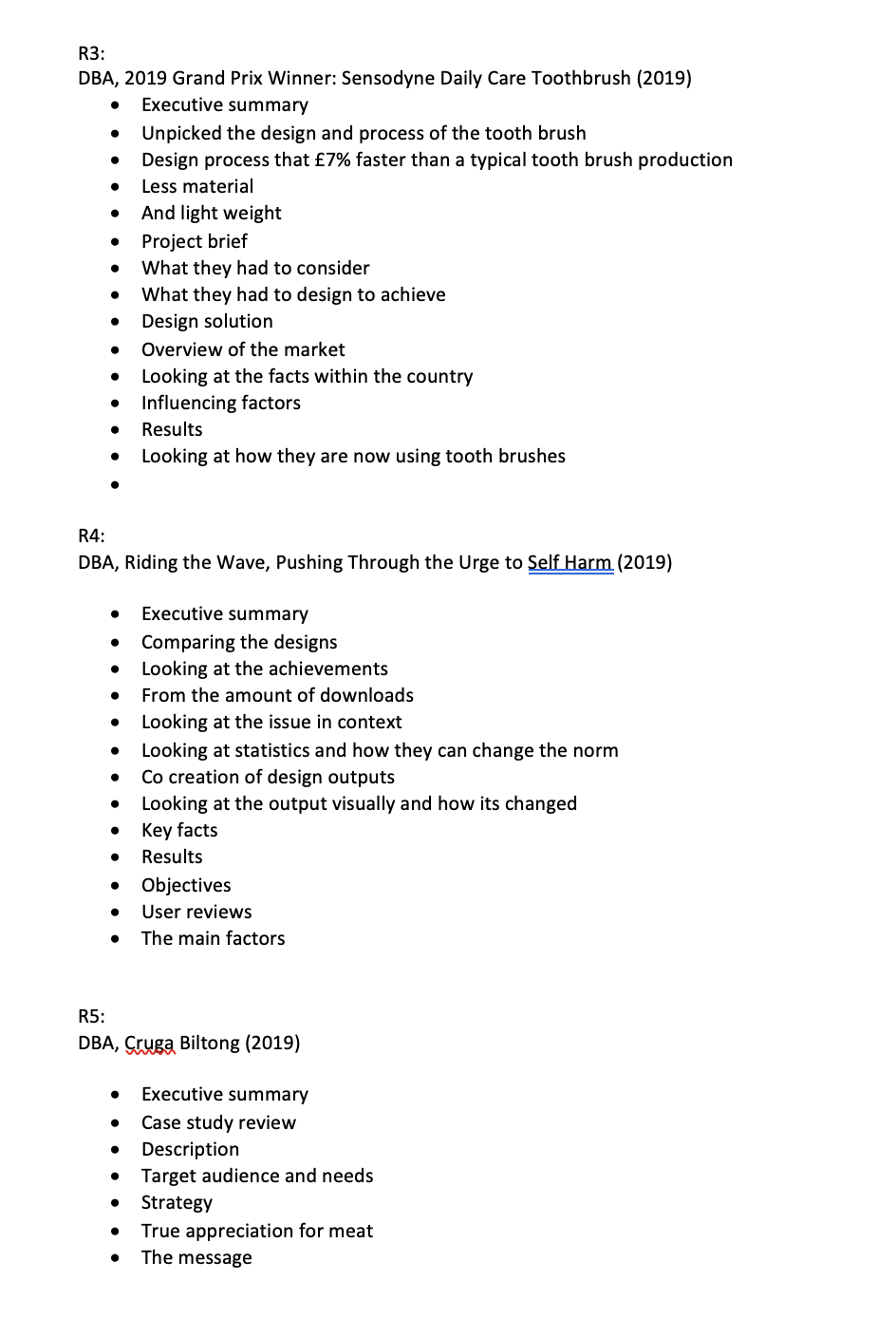Week Twelve
Lecture Notes
Lecture Reflection:
The lecture this week outlined how useful analysis can be to understanding and refining the project. Looking back and what you think was done well or not well but with fresh eyes can give you a clearer understanding and new outlook on each project. Like Dirks talks about how its an ongoing process to gain feedback to then realise where you are able to improve to then change again. I feel this is a good process to go through.
Resource Notes:
Resource Reflection:
R1 + 2
These two resources were slightly different but followed on from one another. But it outlined how to look at the sucess of a project all from a designers point of view. You can measure sucess from a career perspective aswell as looking a the design process. Answering questions like did I gain knowledge of the industry within this project? did i continue to educate myself and improve? I also thought it was an interesting point to mention that failure only happens when teams don’t connect.
R3 + 4 + 5
All of these case study reflections were really interesting, they told a narrative right from the start and I really focussed on what they each included. Which allowed me to look at the structure of the documents and what they each had in:
Executive summary
Comparing designs
Case study review
Description
Context of issue
Stats
Target Audience
Design putputs
Key facts
Results
Objectives
User reviews
Workshop Challenge:
Finalise the design of your ‘Industry Set’ project.
Write short notes to evaluate the success (or failure) of your Industry set project and ensure you articulate the project’s relationship to the original brief, strategy and project plan. Gather target audience and key stakeholder feedback and reflect on what worked, what didn’t work and what you would do differently.
Engage in discussion on the Ideas Wall and add your reflective notes to your blog.
Record a five minute video presentation to evaluate the success (or failure) of your industry set project. We want you to reflect on the different stages, from concept development to final outcome, and demonstrate how your project has evolved over the last eight weeks. Please note, we want you to evaluate your project to gain a fresh insight and not simply summarise each stage over the last eight weeks.
Record your presentation in the format of your choice (for example, a voice recorded Keynote or Powerpoint slide presentation, video recording or podcast).
Upload your video presentation to your blog.
To start this week off, I went to create a presentation of the summaries of the project:
How the project has evolved
Evaluation
what did i do
The design process was a journey through different creative ideas, here talk through the steps of coming up with a concept.
how did i do it
The research and the different route that you took to undertake research.
what worked
The audience research definitely worked and helped with the process of understanding, I think the itneractive solution works. aswell as the rest of the concept.
what didn’t work
The advertising could have been worked upon, but I feel that every aspect worked.
what would i do differently next time
I would have changed my creative thinking and potentially gone down a different channel to look at something that was more abstract.
what would i do to extend the project
Continuing with the same avenues I would have made the online version of the installation.
did it achieve its aims
I feel it did achieve its aims, I was meant to create something that was fun and interesting and i have felt that I have done this within the project. I have also completed all my personal objectives.
In this video I will be presenting my response to the science museum brief, creating an interface that will engage with the target audience of 18-30 year olds.. I have explored a physical approach creating an interface that can be placed within an installation.
I started the project by doing background research to understand the current online archive. Looking at the statistics, it was clear that people were mainly using the archives for studying and not many were using it for personal interests.
I also researched the core values of the science museum group and what they stood for.
Using the double diamond approach, I outlined what tasks I needed to achieve each week to complete the brief.
I also created personal objectives that gave me a focus across the whole project.
I went onto start to write down ideas, surrounding all the research that I had done. Using the methods that were outlined in the lecture by Luke Veerman in week 8 about writing down all the ideas even when you run out of ideas, Through this method I was able to mind map and come up with 2 main concept ideas for my research question, How can personalisation allow for the user to connect with the archives?
I developed my ideas using three different approaches, a visit to the science museum, a questionnaire and research on the trends:
An important reference was the fjord trends article, it was clear that trends have changed over the course of the pandemic, meaning brands are starting to look at new ways of delivering experiences. There is also a huge part on interaction and how the design relationship between audience and interaction has changed over this period.
I visited the science museum in London to really understand how people were looking at the artefacts. It was a clear observation that people were interested in places where they could interact with an installation or see how an object worked.
I sent a survey out to my target audience to ask questions surrounding the online archive and the physical museum. The main conclusions from this was that people would be likely to interact with the installation as well as using an interface that produced a personalised outcome.
I found my way to focussing on physical and digital and also having a focus on interactive design.
I changed my concept, due to feeling I had focussed too much on the installation and not how the user would interact and what they would benefit from using it.
I reviewed some case studies that were crucial within the redirection of my project, focussing on the users interaction and how data is used.
This led me to my concept, still focussing on personalisation but creating an installation that would allow the user to connect with the online archive. Due to the vast capacity of the online archive, it is clear that users get lost and not really knowing what is available that would interest them.
The installation would involve taking part in a series tasks which would allow the computer to narrow down the options that were available which would then match you to an object at the end.
I took these tasks and created a process that could then be placed over the top of all the different categories that were available within the online archive. This way if the archive expanded, the system could be updated.
I went onto create the interface, that would sit on interactive screens in the installation, I decided to make these super simple so it wasn’t too overwhelming for the user. Focussing on the user experience, I went onto create a final layout example for the art category. If I was to have more time I would have created an example for each of the categories that were available.
Throughout the prototype stages for the interface, I made sure that I was getting constant feedback from those within my target audience which allowed me to adapt the design when needed, this created a strong design detail for the installation.
The main outcome within the installation, is a postcard where the user can take a selfie with their object match and find out information about the object on the back of the card. The user is able to print this or share. If I had more time I would have done more target audience feedback for this output but also watched how the users interacted with the interface as this would have identified areas in which the installation is not clear.
I extended the project on to creating advertising posters that could be used to showcase the installation. Looking back I would’ve liked to have developed this further. In addition the design could have offered more of a story telling aspect and I would have also liked to develop more sensory interaction including noise, smell and touch.
Looking back I could have also taken the design further looking past the filtration aspects of the online archive, potentially creating something that was more abstract.
If I was going to extend the project, I would have gone on to create the online version of the interface so that the project can be experienced by users globally.
The brief has been met by this design and allows the online archive to be seen in a new light by new users.
Weekly Reflection:
On reflection of the project, It has been a journey through the weeks but I feel it has pushed me creatively to think about aspects of the design that I wouldn’t have considered previously. I have enjoyed researching the many different installations and interactive ways that you are able to connect with brands and objects.
The project has achieved the brief of creating an interface that would appeal to the target audience as well as showcasing the online archive objects.
Away from the brief, I feel I have also achieved my personal aims that I set at the beginning of the project; creating curiosity, allowing for users to return to the interface multiple times and focussing on the interactive, digital and physical elements.
I have throughly enjoyed creating different parts of the installation piece that has come together like a puzzle. The designed output can be expanded with the continuous updating of the online archive but can be also be adapted and changed depending on different events.
The strongest part of the project for me was the user interface pages within the installation. This was due to the strong feedback that I received from my target audience. I feel that the users would engage and throughly enjoy the experience of the installation within any of the science museums
If I had more time I would work on the advertising side of the project as well as the digital installation that would be on the online archive itself, allowing for global audience to engage with the design.




